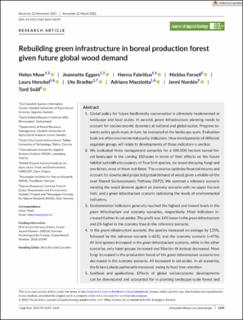Rebuilding green infrastructure in boreal production forest given future global wood demand
Moor, Helen; Eggers, Jeannette; Fabritius, Henna; Forsell, Nicklas; Henckel, Laura; Bradter, Ute; Mazziotta, Adriano; Nordén, Jenni; Snäll, Tord
Peer reviewed, Journal article
Published version

Åpne
Permanent lenke
https://hdl.handle.net/11250/3001581Utgivelsesdato
2022Metadata
Vis full innførselSamlinger
- Publikasjoner fra CRIStin - NINA [2364]
- Scientific publications [1392]
Originalversjon
10.1111/1365-2664.14175Sammendrag
1. Global policy for future biodiversity conservation is ultimately implemented at landscape and local scales. In parallel, green infrastructure planning needs to account for socioeconomic dynamics at national and global scales. Progress to-wards policy goals must, in turn, be evaluated at the landscape scale. Evaluation tools are often environmental quality indicators. How developments of different organism groups will relate to developments of these indicators is unclear.2. We evaluated three management scenarios for a 100,000 hectare boreal for-est landscape in the coming 100 years in terms of their effects on the future habitat suitability/occupancy of four bird species, six wood-decaying fungi and one lichen, most of them red- listed. The scenarios optimize financial returns and account for downscaled projected global demand of wood given a middle-of- the road Shared Socioeconomic Pathway (SSP2). We contrast a reference scenario meeting the wood demand against an economy scenario with no upper harvest limit, and a green infrastructure scenario optimizing the levels of environmental indicators.3. Environmental indicators generally reached the highest and lowest levels in the green infrastructure and economy scenarios, respectively. Most indicators in-creased further in set-asides. The profit was 14% lower in the green infrastructureand 2% higher in the economy than in the reference scenario.4. In the green infrastructure scenario, the species increased on average by 135%, followed by the reference scenario (+65%), and the economy scenario (+47%). All bird species increased in the green infrastructure scenario, while in the other scenarios, only hazel grouse increased and Siberian tit instead decreased. Most fungi increased in the production forest of the green infrastructure scenario but decreased in the economy scenario. All increased in set-asides. In all scenarios, the lichen Lobaria pulmonaria increased, owing to host tree retention.5. Synthesis and applications. Effects of global socioeconomic developments can be downscaled and accounted for in planning landscape-scale forest andconservation management. Accounting for indicators of environmental quality identified forest management scenarios for reaching targets on both revenue and conservation. Rebuilding green infrastructure in the production forest was possible at a relatively minor economic cost and to the benefit of species of con-servation concern.
conservation, downscaling, environmental indicators, forestry, GLOBIOM, green infrastructure, land-use scenario, socioeconomic pathway
